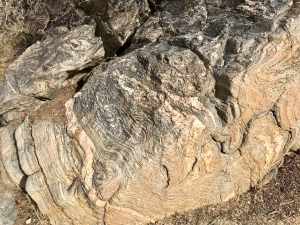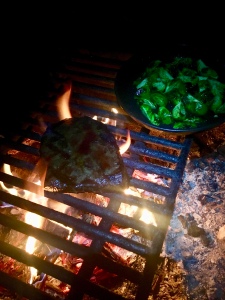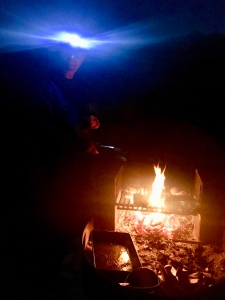I lived in Arizona some 40 years prior to my move to Texas in 2002 and made many a car trip to Southern California – the ocean attracts “Zonies” as nectar does hummingbirds – and never once do I remember stopping at Joshua Tree National Park en route.
My mistake.
Georges and I just spent a glorious four days in the 800,000-acre park and two days in the 700,000-acre Mojave National Preserve, home to the largest Joshua tree forest in the world. We hiked and hiked, and then we hiked some more. We marveled at the thickets of the giant, hairy evergreens nestled amid picturesque rock formations. We basked in the warm, sunny days and cuddled during the clear, cool, star-studded nights.
How did I miss this place all those many years?

Joshua trees, it turns out, aren’t trees at all. They are the largest member of the yucca family. Extremely slow growing, they can take 60-plus years to reach 15-40 feet in height and then live for several hundred years.
The largest Joshua tree on record, according to the park, was 80 feet tall and believed to be some 1,000 years old. That’s impressive: A yucca taller than an eight-story building that began growing nearly a half century before Columbus “discovered” America.
We figure this one is but a babe at maybe a couple hundred years old.


The trees only grow in the Mojave Desert, which as the smallest of North America’s four deserts and includes parts of California and Arizona. (The other three? Chihuahua, Great Basin, Sonoran.) Joshua trees are the signature species of the Mojave Desert, as is the towering saguaro to the Sonoran Desert, where I grew up outside of Tucson about an hour from the Mexican border.
The trees reportedly were named by Mormon settlers who crossed the Mojave Desert in the mid-1800s. Their unusual shape reminded them of the Bible story in which Joshua reaches his hands up to the sky in prayer.

They remind me of a large, lumbering Dr. Seuss character. If you stare at them long enough, and let your mind wander, you can imagine them doing “The Floss” when you turn your back and then freezing their positions when you turn back around to look at them.

The Joshua Tree National Park exists thanks to Minerva Hamilton Hoyt, who according to park literature, was way more than simply a wealthy Southern California socialite. An avid gardener, community activist and a determined visionary, she was outraged when she saw thieves and vandals after World War 1 yank up cacti, Joshua trees and other native plants for sale to urban gardens or to use as target practice. She advocated tirelessly for the creation of a 1 million-acre internationally protected desert preserve stretching from the town of Twentynine Palms to the Salton Sea.
This is a woman who put her money where her mouth was. She personally funded majors exhibitions of desert plants in New York, Boston, and London. The president of Mexico dubbed her the “Apostle of the cacti” and a species of cactus was named in her honor.
Her passion for desert landscapes was apparently contagious. In 1936, President Franklin Roosevelt established the Joshua Tree National Monument, which became a national park in 1994.
The rock formations in the area are as impressive as the twisted spike-leafed trees.

Many of the formations are named and identified by the park service. Most are accessible via short hikes. This is Skull Rock, identifiable per its eye sockets.

This is Face Rock, at profile.

This next one on the Split Rock Trail has no official name, but I see quite clearly a big-eared, sad-eyed elephant with a long trunk. Do you? I wonder what the process is to get this mama elephant properly named and recognized….

These rock formations are the product of magma that crystallized some 85 million years ago some 15 miles beneath our feet. Earthquakes stressed and cracked the rock, and mountain uplifting moved the rock closer to the earth’s surface. According the information plaque, groundwater then seeped into the cracks, rounding and shaping the rock blocks. Once exposed above ground, weathering and erosion sculpted the granite into the shapes we see today, making this area a Mecca for rock climbers.
Look carefully and you can see several of the rock climbers on top of the rocks near the center of this next photo. Look even more closely and you can see another climber beginning the ascent, barely a fifth of the way up the large crevice those on top have already scaled.

One day, we drove up to Keys View where we could see all the way to Mount San Gorgonio in the San Bernardino Mountains to the northwest, the highest peak in Southern California and the seventh highest in the 48 contiguous states. Turning our heads in a more southerly direction, we could actually see across the San Andreas Fault, where the Pacific and North American tetontic plates collide, and all the way to the Salton Sea.
iPhone photos don’t really do such scenery justice, but I tried anyway. Here is a photo looking northwest-ish toward Mount San Gorgonio. If you expand the photo with your fingertips you can see rows and rows of tiny toothpicks in the Valley beneath and to the right of the peak. Those are windmills, powered by gusts blowing inland from Los Angeles.

This photo is looking more southwest-ish. That blue just above the mountains in the center of the photo (use your fingers) is the Salton Sea.

Another day we took the more ambitious, nearly seven-mile Panorama Loop hike with its 1,200 feet elevation change. The first third was strenuous, but our picnic on top and the views, plus the more gradual descent of the second two-thirds, made it exceptionally enjoyable.
G is a geology buff and he was clearly in his element here.
Rocks are to Georges what words are for me – distinctive, fascinating, full of meaning. I discern this word from that, carefully crafting sentences for precision and allure. G discerns igneous from sedimentary from metamorphic rock, carefully identifying the sub-categories within and describing how they originated, progressed and came to be as we know them today.


I look at these formations and see shades of Van Gogh’s Starry Night. (Use your fingers to enlarge the photos to get the full effect of the swirls in the strata.) G looks at these formations and sees Migmatite, a form of metamorphic rock that’s as intriguing to him as the latest elegantly written Amor Towles novel is to me.
We drove down Wilson Canyon to the Cholla Cactus Garden, where the smooth, rounded boulders of granite turned to craggy-edged strata of rhyolite. One minute we’re in an orchard of Joshua Trees, the next we’re in a thicket of cholla cactus.
What a gift Minerva Hamilton Hoyt foresaw.

The rocks and vegetation were just as impressive in the Mojave National Preserve, where early one morning we did the short but lovely Rings Loop Trail, named for obvious reasons, as you can tell from this photo. There were two sections where the canyon walls are so steep you must use the rings to climb-crawl through.


We picked a great time to visit the area. The days were warm, the evenings cool. And since November is just at the start of the season, there were ample first-come-first-serve campsites available for people like us who don’t want to have to keep a schedule with reservations.
Mostly we like campsite dinners. These shots from our $6 campsite in Mojave National Preserve show why.




But we made an exception one evening in Joshua Tree and reveled in an unexpectedly fabulous dinner at the highly-recommended-with-good-reason Pappy & Harriet’s steakhouse in nearby Pioneertown. Our flat-iron and skirt steaks were cooked to perfection, the service was fun and attentive, the live music infectious.


The week we were at the Black Rock Canyon campground coincided with the Joshua Tree Half Marathon, one in a series of cool national-park-focused races across the country called “Vacation Races: Run Where You Play.” This race was unique in that it started 6:15 p.m. – just after the sun went down. The route was entirely on dirt and trails near the national park. Our campground was packed on Saturday night with runners in tents and trailers – young and old, from near and far, all physically fit and clearly enjoying nature’s wonders.
We loved our time here, but soon it felt like time to move on. We decided to drive a bit on this famed highway to find our way to the next adventure in our Year on the Edges of America….


Keven
I hope you remember meeting Pam and I at Hole in the Wall campground? We enjoyed our brief chat and so I felt a brief e mail was warranted. Pam and I are now back home in Campbell CA after a very interesting 3 week 3,700 mile trip. We went as far east as Chaco Canyon NM which was a real revelation to both Pam and I. I am enjoying reading your blog, best of luck with your ongoing travels and maybe our paths will cross again someday.
LikeLiked by 1 person
How wonderful to hear from you! Of course we remember you both. It was great fun chatting with you. I believe you said you’ve lived in the Bay Area for 25 years. We took note of your disappointment in Denali and of your enthusiasm about X park with the hot tubs! We arrived in Tucson yesterday and will stay the holidays here before heading back toward Dallas after the first of the year. So glad you’re enjoying the blog! Please let us know of any suggestions … and yes, it would be grand to meet up again some day! Best to you and Pam always!
LikeLike
PS “A Gentleman in Moscow“ is one of my favorite books.
LikeLiked by 1 person
Me too! I actually love it even more than Rules of Civility. And I loved that book too.
LikeLike
Read them both. Prefer The Gentleman from Moscow. I was enchanted by it from start to finish. Love that you enjoyed Joshua Tree. Grew up in California and have vivid memories of the amazing sky with uncountable stars. My aunt had a cabin on a lot outside of town 60 years ago, so you can imagine how undeveloped it was.
LikeLiked by 1 person
Wow. I’ll bet the cabin’s night view was fabulous! Actually, the day view was probably pretty darn good too. Yes, I thought the writing, irony, history, humor of Gentleman was exquisite.
LikeLike
Fantastic photos! Really like the one with casita in the background and camp fire in foreground. An intriguing photo for the cover of a book? I see the elephant rock as well. Get that rock named! We’ve had Joshua Tree NP on our list numerous times but haven’t made it into the park. I enjoyed the tour. One of my favorite things about many of your posts is the history and the informative piece. Another enjoyable read.
LikeLiked by 1 person
Thanks, Jane! Both Joshua and Mojave were unexpected pleasures. We planned to stay just a night or two and wound up extending our visit quite a bit. Highly recommend the experience.
LikeLike
Still following you in your adventures. We loved Joshua Tree too but looks like you really explored it to the max!
LikeLiked by 1 person
Fun to know that we have so many interests in common!
LikeLike